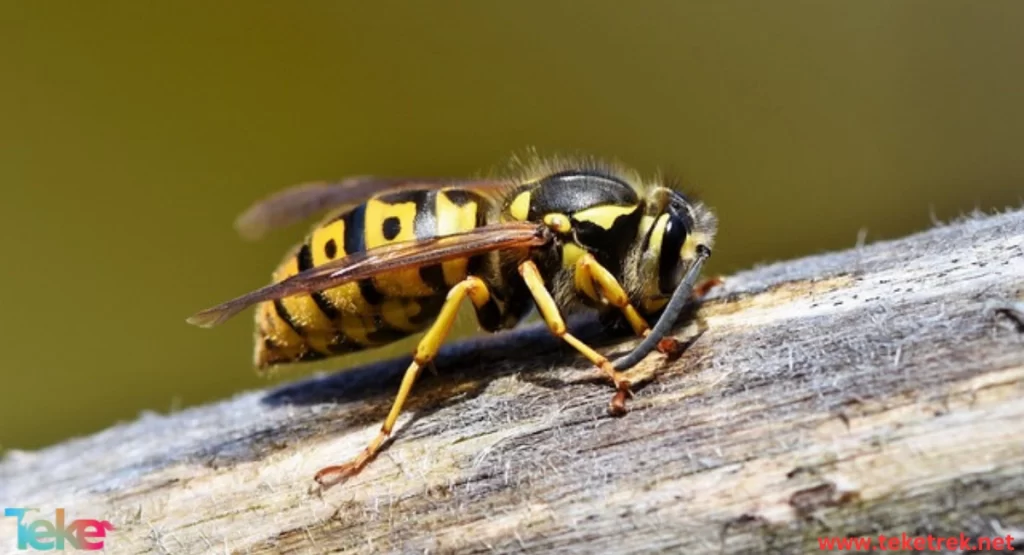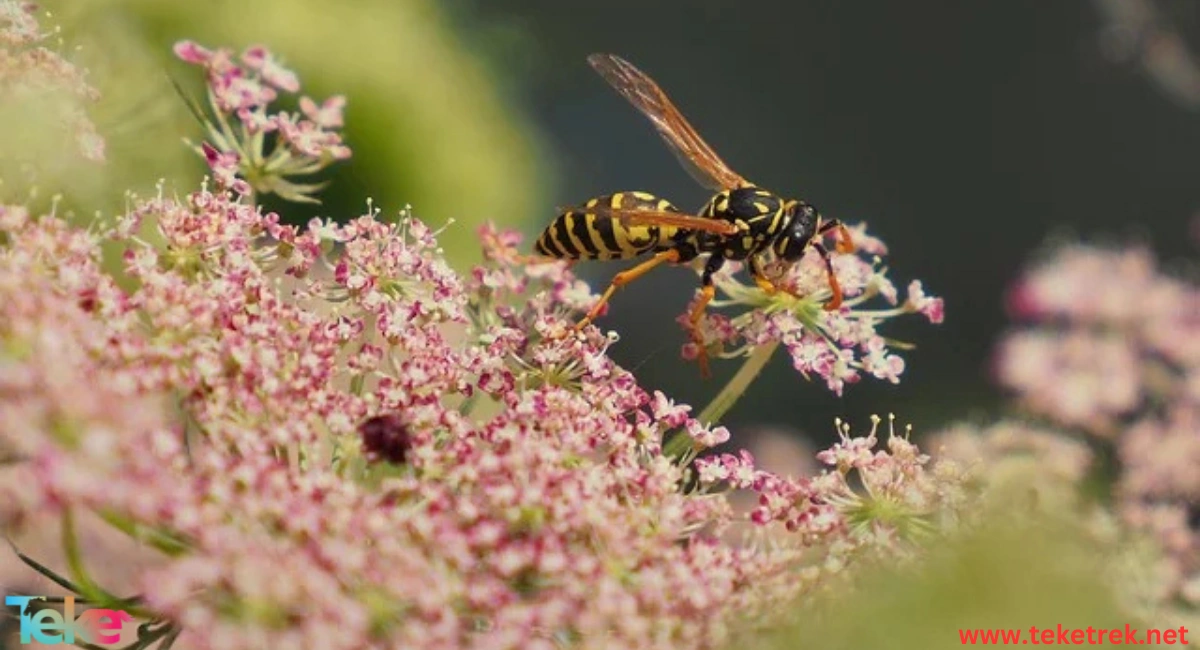Undoubtedly, you’ve experienced the painful sting of a wasp at some point, which might have led to your dislike of this aggressive insect. But have you ever wondered about the reason behind the wasp’s aggressive behavior? And do you want to know about its lifestyle? If your answer is yes, continue reading the following article in TekeTrek Website, where you’ll learn about the characteristics of wasps, their diet, and their way of life.
What is a wasp?
Wasps can be distinguished from other insects by their large size, painful sting, and aggressive behavior when their nest is threatened. Wasps are generally divided into two genders: Vespula and Dolichovespula.
Vespula wasps
- These wasps build their nests in the ground or in similar hidden locations, while Dolichovespula wasps are aerial and construct their nests several meters above the ground.
- Wasps are beneficial social insects because they help control some insect pests. Although they can be aggressive, wasps only attack when provoked.

The Wasp’s appearance
- Wasps consist of three body segments: the head, thorax, and abdomen. The body is usually tapered towards the rear, enabling swift flight. The body color can vary but typically features shades of black, yellow, and brown.
- The head is typically large and tapered with two large eyes. It contains powerful jaws equipped with claws for hunting and defense. The head also bears relatively long antennae composed of 12 to 13 segments.
- The thorax carries a pair of wings, with the front wings longer than the hind wings. The wings are transparent, allowing the wasp to fly easily, and are usually attached to the thorax. They are often covered in dark-colored hair.
- The posterior abdomen of the wasp contains the reproductive organs for males and females.
- Wasps have six strong legs used for movement and grasping prey. A wasp may have distinctive patterns on its body, such as lines or dots, which vary among species.
- Different species can be easily distinguished from each other based on the yellow or white and black markings on the abdomen.
Wasp Nesting Locations
- Homes and buildings typically provide shelter, food, and water easily accessible to these insects. Therefore, wasps prefer to nest in them during the warmer months, exploiting any cracks in building foundations, broken windows or doors, or similar openings.
- When outdoors, wasps build nests hanging from edges, tree branches, shrubs, or within tree cavities.
Types of Wasps
Bald-Faced Hornet (BFH):
- The aggressive nature of the bald-faced hornet makes it a formidable insect, fiercely defending its nest. This type of wasp aggressively pursues its prey for long distances and stings repeatedly.
- Nests built by bald-faced hornets atop tall trees or away from human traffic pose little to no threat to people. However, nests located near human activity, homes, or similar areas can be highly dangerous.
European Wasp:
- Often referred to as “gentle giants” due to their docile nature, European wasps become aggressive when their nest is threatened. Unlike BFH, European wasps rarely build their nests in the open. Nest locations include tree sides, around rocks, inside tree trunks, hollow tree stumps, and in house walls.
- European wasps are beneficial as they prey on flies, spiders, and other wasps. Although they do not pose a significant threat to humans, like other stinging insects, they can be dangerous depending on the nest’s location.
Mud Daubers:
- Unlike other wasp species, mud daubers are solitary and non-aggressive, meaning they do not live in colonies. As their name suggests, they construct their nests from mud but do not defend them. Nests are built in protected locations—under eaves, on patio roofs, in garages or sheds, and on protected building walls. Holes present in abandoned mud tunnels may indicate the nest is inactive, but be cautious, as other wasps may take over abandoned mud tunnels. Adult mud daubers feed on plant nectar, honeydew, and spider bodily fluids.
Paper Wasps:
- Paper wasps are semi-social insects, forming small colonies without a worker caste. They derive their name from the paper-like material they use to construct umbrella-shaped nests. Nests are hung from patio ceilings, window and door frames, wooden rafters in attics, railings, and other protected locations. They have exposed open cells where eggs are laid.
- Paper wasps are not inherently aggressive but will sting if provoked or if their nest is disturbed. They feed on nectar and other insects, including larvae and flies.
Habitat, Diet, and Life Cycle
Habitat:
- Generally, wasps are attracted to urban environments and other populated areas. Many aerial and ground-nesting wasp species build their nests either on or inside human-made structures. Nests are often found within wall voids, window frames, and in natural settings such as meadows. Pests establish colonies in shrubs, underground, in hollow trees, under bark, and in rock piles.
Wasp Diet: What do wasps eat?
- The adult wasp’s diet primarily consists of fruit juices, honey, nectar, and other sweet liquids like soda. Wasp larvae feed on animal carrion, prepared meat scraps, and soft-bodied insects such as cockroaches, beetles, large flies, and larvae. Even workers of various wasp species and other insects are brought back to the nest by adults.
Life Cycle:
- The life cycle of a wasp begins with an egg laid by the queen. Once hatched, the larvae are fed by worker wasps until they pupate. Pupae then transform into adults, emerging to take on various roles within the colony. The queen lays eggs, and the cycle continues. The lifecycle duration varies among species, affected by factors such as temperature and food availability.
Reproduction in Wasps
Every autumn, wasp colonies produce males and females that mate before the onset of winter. The fertilized females are the only members of the colony that spend the winter in protected locations. When females emerge in spring, they seek suitable sites for new colonies and immediately assume the role of queens. The queen constructs a nest consisting of twelve cells, laying and caring for the first batch of eggs. In addition to nurturing the young, the queen assumes all responsibilities herself. Canadian wasp species typically build nests containing anywhere from 100 to 400 individuals. The entire cycle repeats annually.
Preventing Wasp Invasions
Preventing pests from infesting is challenging since wasps can travel long distances and utilize flowers and other insects as food sources. Before mated females emerge after each winter, homeowners should check potential entry points around the house. Sealing cracks with caulk and replacing torn or broken screens is the best way to prevent indoor wasp invasions. Additionally, pest control specialists can safely treat and remove nests.
How much concern should I have about wasps?
- Wasps are extremely aggressive and defend their nests. If wasps detect a threat to the colony, they will deliver an extremely painful sting, which can cause potentially fatal allergic shock to a sensitized individual if not treated immediately.
- While wasps can be beneficial in controlling other insect pests, some species can damage trees and shrubs by binding branches with nest-building materials and sap.
The reason for the presence of a wasp in the house
Reasons for wasps being in the house could include them seeking shelter, often finding openings or cracks as entry points. Additionally, the presence of food resources inside the house may attract them.
Some tips for getting rid of wasps:
- Remove any old nests.
- Keep recycling containers clean and tightly sealed.
- Seal up any holes where wasps may re-enter the building.
- Seal up openings with caulk or expanding foam.
- Before outdoor events, use a water sprayer on flowers to temporarily deter wasps from the patio and visiting flowering plants.


Questions and answers about wasps
- Is the wasp harmful?
Wasps are aggressive insects, and if they perceive a threat to their colony, they will inflict a very painful sting, which can cause a potentially fatal allergic reaction in someone with an allergy if not treated immediately.
- Does a wasp sting kill?
Generally, a wasp sting is not lethal to humans, but it can be extremely painful and cause an allergic reaction in some individuals. If you have a wasp allergy, the sting can be dangerous and require immediate medical care.
- What does the wasp do to humans?
In some cases, a wasp may sting a human if it feels threatened or disturbed, and its sting can be painful and may cause an allergic reaction in some people. However, wasps play an important role in the ecosystem by controlling pest insect populations and pollinating plants.
- What is the difference between a wasp and a bee?
The main difference between a wasp and a bee lies in their nature. The term “wasp” usually refers to aggressive insects that can sting and be painful, while “bee” typically refers to bees, which live in large colonies and produce honey.
- What is wasp slang for?
In slang, “wasp” is often used as an acronym to refer to “White Anglo-Saxon Protestant,” which describes a person of Anglo-Saxon, Protestant descent, typically from a wealthy or privileged background. It’s a term sometimes used to describe a particular social or cultural group.
- What happens if you get stung by a wasp?
If you get stung by a wasp, you may experience pain, redness, swelling, and itching at the sting site. Some people may also have allergic reactions, ranging from mild to severe.
- What to do if you see a wasp?
If you see a wasp, try to remain calm and avoid sudden movements. Slowly and calmly move away from the area where the wasp is without disturbing it. Avoid swatting at it or making any sudden gestures that might provoke it. If you’re outdoors, seek shelter indoors or move to a different area. If you’re indoors, close windows and doors to prevent the wasp from entering. If you’re stung, follow appropriate first aid measures and seek medical attention if needed, especially if you have allergies or experience severe reactions.
In conclusion, because wasps can travel long distances, deliver painful stings, and use flowers and other insects as a food source, removing and deterring them can be challenging. Only a specialized pest control service can effectively eliminate a wasp invasion and safely remove a wasp nest.






